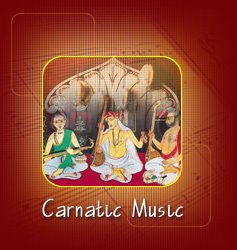Origins and history
Like all art forms in Indian culture, Carnatic Music is believed to have a divine origin - it is believed to have originated from the Gods. However, it is also generally accepted that the natural origins of music were an important factor in the development of Carnatic music. Ancient treatises describe the connection of the origin of swaras to the sounds of animals and birds, and man’s keen sense of observation and perception that tried simulating these sounds - after hearing and distinguishing between the different sounds that emanated from bamboo reed when air passes through its hollows, man designed the first flute. In this way, music is venerated as an aspect of the supreme (nāda brāhmam). Folk music is also said to have been a natural origin of Carnatic music, with many folk tunes corresponding to certain Carnatic ragas
The Vedas are generally accepted as the main probable source of Indian music. The Sama Veda is said to have laid the foundation for Indian music, and consists mainly of hymns of Rigveda, set to musical tunes which would be sung using three to seven musical notes during Vedic sacrifices.The Yajur-Veda, which mainly consists of sacrificial formulae, mentions the veena as an accompaniment to vocal recitations during the sacrifices
References to Indian classical music are made in many ancient religious texts, including epics like the Ramayana and Mahabharata. The Yajnavalkya Smriti mentions "Veena vadhana tathvangna sruti, jathi, visartha talanjaaprayasena moksha margam niyachathi" ("The one who is well versed in veena, one who has the knowledge of srutis and one who is adept in tala, attains salvation without doubt.").Carnatic music is based on music concepts mentioned in Bharata's Natya Shastra. The Natya Shastra mentions many musical concepts (including swara and tala) that continue to be relevant to Carnatic music today
According to some scholars, Carnatic music shares certain classical music concepts with ancient Tamil music. The concept of Pann is related to Ragas used in Carnatic music. The rhythmic meters found in several musical forms (such as the Tiruppugazh) and other ancient literature, resemble the talas that are in use today.
Both Carnatic and Hindustani music shared a common history. Since the late 12th and early 13th centuries, as a result of the increasing Persian influence (and as a result of the Islamic conquest) in North India, Hindustani Music started evolving as a separate genre, while Carnatic music was relatively unaffected by these Arabic and Iranian influences. In Carnatic Music (which was based in South India), the pan-Indian bhakti movement laid a substantial basis as far as the use of religious themes are concerned, while major developments post 13th century also contributed to its divergence from Hindustani music.
Carnatic music saw renewed growth during the Vijayanagar Empire by the Kannada Haridasa movement of Vyasaraja, Purandara Dasa, Kanakadasa and others. Purandara Dasa who is known as the Sangeeta Pitamaha (the grandfather of Carnatic music) laid out the fundamental tenets and framework for teaching Carnatic music. Venkatamakhin is credited with the classification of ragas in the Melakarta System and wrote his most important work; Chaturdandi Prakasika (c.1635 CE) in Sanskrit. Govindacharya expanded the Melakarta Scheme into the Sampoorna raga system, which is the system in common use today.
Even though the earlier writers Matanga, Sarangadeva and others also were from Karnataka, the music tradition was formally named Karnataka Sangeetham for the first time only in the 13th Century when the Vijayanagara empire was founded.
Subscribe to:
Post Comments (Atom)



No comments:
Post a Comment